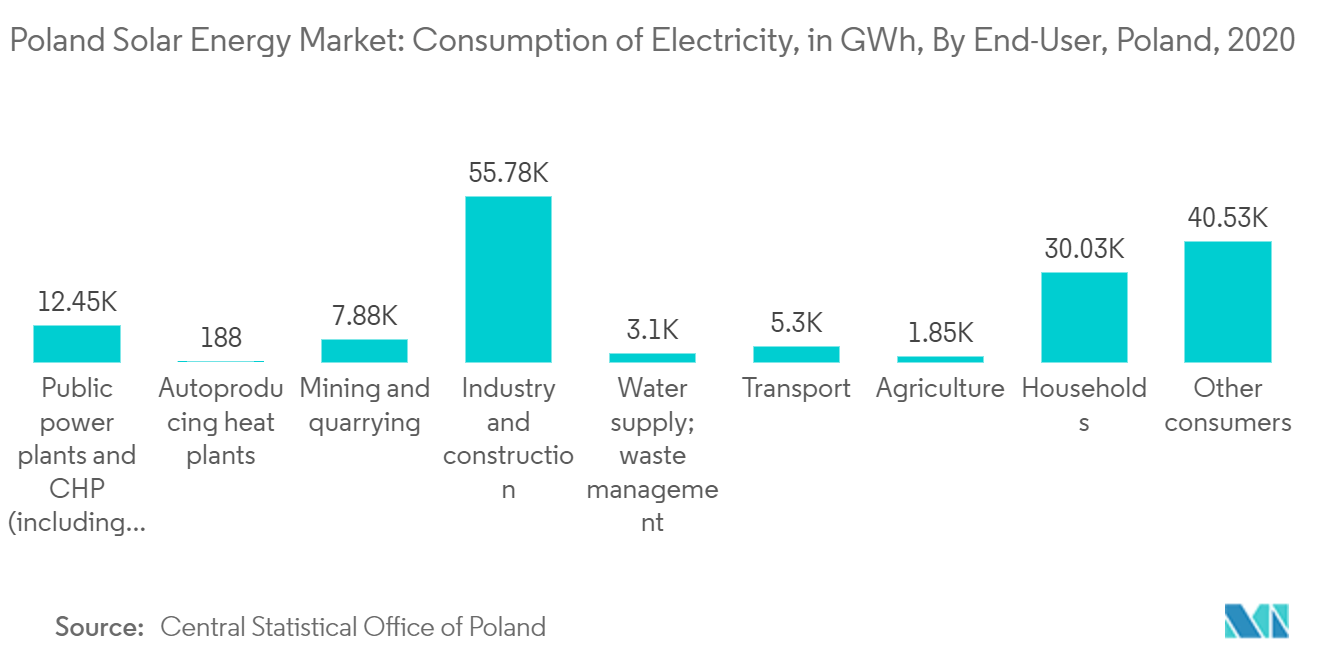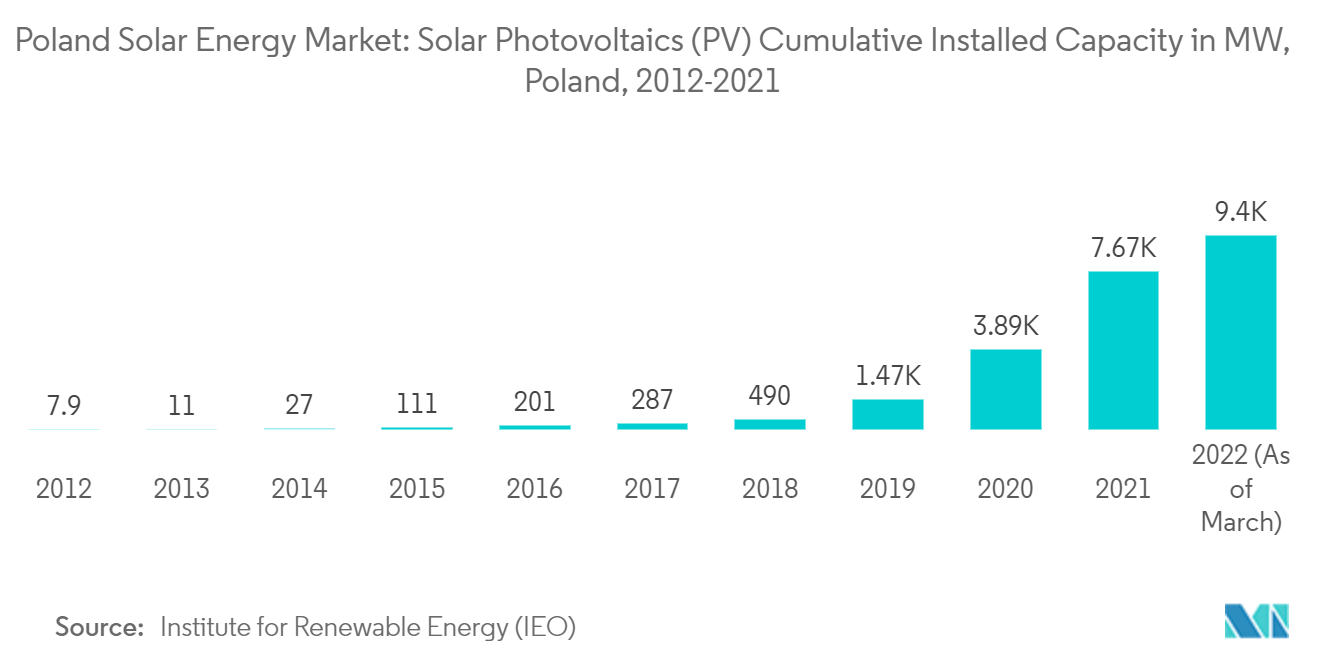Market Trends of Poland Solar Energy Industry
This section covers the major market trends shaping the Poland Solar Energy Market according to our research experts:
Residential End-User Segment to Witness Significant Growth
The residential end-user segment is expected to witness considerable growth during the forecast period due to the increased government support and the declining cost of solar PV in the residential sector. The solar energy system in the residential sector is composed of rooftop solar PV systems used in households, in most cases in conjunction with the energy storage system (ESS) systems. The primary investment in residential solar PV systems is the cost of solar modules and related hardware, such as an inverter, metering equipment, and other components.
According to the Central Statistical Office of Poland, in 2020, the country consumed 1,57,086 GWh of electricity; the household sector consumed around 20% of total consumption with 30,037 GWh. The solar energy industry in Poland is developing at every level, from smaller, privately-owned rooftop PV systems and commercial rooftop systems to large free-standing installations. According to the Polish Society for Photovoltaics, the number of registered small-scale systems (below 50 kW) with an average capacity of 6.5 kilowatts (kW) grew from 460,000 (3 GW) in 2020 to 845,00 (6 GW) in 2021. These small-scale systems account for 80% of the total PV power installed in Poland.
In April 2022, the government announced the fourth edition of the My Electricity program. The government focuses on the need to increase the self-consumption of energy produced from solar PV installations, for which the funding will be provided not only for photovoltaic installations but also for energy storage facilities and systems for managing this energy. According to Poland Renewable Energy Association, the maximum co-financing for micro-installations and energy storage can reach over PLN 20,000. These initiatives are expected to boost the residential solar segment's growth during the forecast period.
The price of CO2 emissions permits is rising; it reached an astronomical level of EUR 80 per tonne in 2021, resulting in increased electricity bills for individual consumers. Therefore, solar PV installation in homes solved this problem, allowing investments to be recouped in as little as six years. In 2021, Poland's residential sector consumed over 32% of the nation's electricity. Hence, using solar PV technology is anticipated to help reduce the country's overdependence on coal, reducing greenhouse gas emissions. In March 2022, EDP - Energiasde Portugal SA is expected to expand its footprint in Poland by acquiring Soon Energy Poland Sp.zo.o., which owns more than 25 MWp of installed solar projects. The company plans to sell, build, and maintain decentralized solar installations in residential establishments in Poland.
Therefore, due to the above-mentioned factors, the residential solar energy segment is expected to grow considerably during the forecast period.

Favorable Government Policies and Initiatives to Drive the Market
Poland has become one of Europe's largest solar PV investment markets. According to the Polish grid operator Polskie Sieci Elektroenergetyczne (PSE), in 2021, more than 3.7 GW of new solar PV additions were made in the country. The total installed solar PV capacity was recorded at 7.67 GW in 2021. According to the Institute for Renewable Energy (IEO), the country's solar PV capacity is expected to reach 12 GW by the end of 2022. The growth of the solar energy sector has been fueled primarily by supportive government policies at both the country and European Union levels, which have benefited both prosumers and utility-scale solar power plant owners. The Polish solar energy market is dominated by prosumers that numbered nearly 1 million. It accounted for more than 50% of the total installed solar capacity.
The Polish government introduced several incentive schemes to install and generate solar power for systems of all capacity ranges. The country has a contract for difference (CfD) system based on a difference between the market price and reference price agreed upon in an auction. Auctions are organized by the Polish government, allocating a budget, deciding on technologies allowed to bid and sizes of installations, and determining a budget per basket. To incentivize the adoption of solar energy, in 2021, the Polish government extended the auction system for another six years (2022-2027). It introduced a net-billing system, replacing the older net-metering system for consumers. In August 2021, the government amended the Renewable Energy Act and extended feed-in tariff (FIT) schemes for renewable energy installations. According to the act, renewable energy installations up to 10 kW (micro-installations) will be supported with the FITs of 0.75 PLN/kWh for solar energy micro-installations up to 3 kW and FITs of 0.65 PLN/kWh for micro-installations between 3 and 10 kW. The FITs apply for 15 years, counting from the date of putting the installations into service, no longer than until December 2035 for solar energy installations. On April 15, 2022, the Polish government announced the fourth edition of the My Electricity program. Under the fourth edition of the My Electricity program, the government has focused on the need to increase self-consumption of energy produced from PV installations, for which the funding will be provided not only for photovoltaic installations but also for energy storage facilities, both heat and electricity, and on systems for managing this energy. According to Poland Renewable Energy Association, the maximum co-financing for micro-installations and energy storage can reach over PLN 20,000.
Hence, such government policies and incentives are expected to accelerate the growth of Poland's solar energy market during the forecast period.


